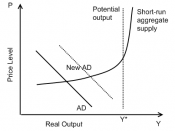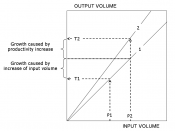7 ECONOMIC GROWTH
Economic Growth involves an increase in the volume of goods and services that an economy can produce over a period of time. It is measured by the annual rate of change in real GDP ie. The % increase in the value of goods and services over a period of one year, adjusted for the rate of inflation.
The ABS uses a variety of approaches for measuring GDP in Australia. These measures are known as the GDP(Income), GDP(Production) & GDP(Expenditure) methods. The official measure of economic growth takes an average of these 3 indicators of growth and is known as GDP(A)
7.1 The Components of Aggregate Demand
John Maynard Keynes, developed a theory which stated that the most important influence on economic growth was the total level of spending in the economy - that is, the level of aggregate demand. If households and business firms were generally pessimistic about the future economic outlook, housholds would tend to spend less on consumer goods and save more and business firms would be reluctant to invest in capital goods.
This would result in an overall decline in aggregate demand, with falling production and rising unemployment.
The economy is in equilibrium where:
AD = C + I + G + (X-M)
Aggregate Supply = Aggregate Demand
The Circular Flow Model reveals that, based on the aggregate demand equation above, certain economic factors can be identified that are either leakages or injections to the overall level of economic activity. The economy is in equilibrium when leakages(S,T,M) = injections(I,G,X)
An increase in leakages causes a downturn in the level of economic growth, and an increse in injections causing an upturn.
Influences on consumption
Consumer expectations
If consumers expect a higher rate of inflation, higher real incomes or future shortages of goods then they would...


